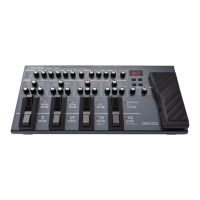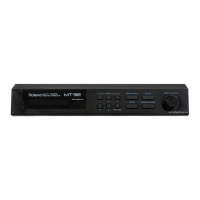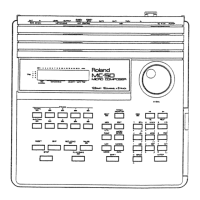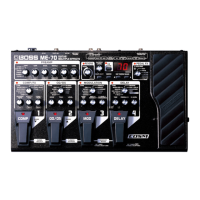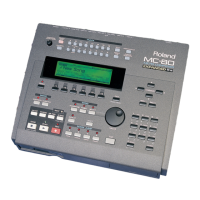Do you have a question about the Roland M-GS64 and is the answer not in the manual?
Provides essential guidelines for safe electrical grounding practices to prevent electric shock.
Guidelines for connecting and operating the unit's power supply safely.
Advice on optimal positioning of the unit to avoid interference and ensure proper ventilation.
Instructions for cleaning and caring for the unit to ensure its longevity and appearance.
Information about the unit's battery backup for memory and precautions for data preservation.
Step-by-step guide on connecting the unit and powering it on safely.
Explains the two primary operating modes: Patch Select and Edit modes.
Guide to selecting and playing sounds (Patches) and understanding Parts.
How to choose sounds (Patches) and drum sets using Program and Bank numbers.
How to silence individual Parts temporarily during playback or editing.
How to isolate and listen to individual Parts for editing and sound checking.
Procedure for modifying and storing custom sounds as User Sounds.
Details on setting parameters for individual drum instruments within a Drum Set.
Explains the two operational modes affecting effect and parameter settings.
Information on the two sound maps available for desktop music systems.
Details on the unit's voice allocation and limitations on simultaneous notes.
Overview of basic parameters including Level, Pan, Reverb, Chorus, Key Shift, and Tune.
Details on various effect parameters like Reverb Type, Chorus Type, and Delay Type.
System parameters that control overall unit behavior like Input Mode and Bulk Dump.
Explains how the Select indicator functions as a level meter for Patches or Parts.
How to display the status of incoming MIDI messages for each Part.
A simplified mode for selecting Patches and Sound Maps without using Edit mode.
How to select Patches while still in Edit mode using the Select button.
Reverses the direction of parameter selection using the Select button.
How to play the currently selected sound for checking pitch and tuning.
Allows quick jumping to specific Parts (A01, A16, B01, B16).
How to select sounds (Patches) and drum sets remotely using MIDI messages.
How to change Drum Sets by transmitting MIDI Program Change messages.
How the unit handles exclusive data received via MIDI IN connectors for Parts.
How the unit transmits exclusive data using its single MIDI OUT connector.
Solutions for common operational problems and unexpected behavior of the M-GS64.
Details MIDI messages the unit receives, covering Channel Voice and Control Change.
Map showing addresses for individual parameter transmission via MIDI exclusive messages.
Maps addresses for system-wide parameters affecting the entire unit.
Maps addresses for common patch parameters affecting all Parts.
Parameters for customizing and saving User Patches.
Parameters for customizing and saving User Drum Sets.
Information on requesting and transmitting bulk data dumps of unit settings.
Requests and transmits a list of preset sounds (Patches).
Requests and transmits a list of preset Drum Sets.
Requests and transmits a list of instrument names within Drum Sets.
Demonstrates calculating checksums for MIDI exclusive messages.
How to adjust individual note pitches for various tuning scales like Equal Temperament.
Table showing parameters and their display values for the basic menu.
Table showing parameters and their display values for Part parameters.
Table showing parameters and their display values for drum setup.
Table showing parameters and their display values for effect parameters.
Lists value ranges and display formats for Matrix 0 parameters.
Lists value ranges and display formats for Matrix 1 parameters.
Lists value ranges and display formats for Matrix 3 parameters.
How to save unit settings using Bulk Dump to an external device.
Explains how the Select indicator functions as a level meter for Patches or Parts.
How to display the status of incoming MIDI messages for each Part.
Explains common error messages displayed by the unit and how to resolve them.
How to select Patches using Program Change and Bank Select MIDI messages.
How to change Performances using Program Change MIDI messages.
How the unit switches between Patch Table 1 and 2 based on MIDI messages.
A reference guide to parameters within Part Param 1, Part Param 2, Master, and MIDI Rx.
Solutions for common operational problems and unexpected behavior of the M-GS64.
Explains the structure and components of Roland's exclusive MIDI messages.
Describes the technique of addressing data for transfer via exclusive messages.
Illustrates how data is exchanged between devices using MIDI messages.
Details MIDI messages the unit receives, covering Channel Voice and Control Change.
Map showing addresses for individual parameter transmission via MIDI exclusive messages.
Maps addresses for system-wide parameters affecting the entire unit.
Maps addresses for common patch parameters affecting all Parts.
Parameters for customizing and saving User Patches.
Parameters for customizing and saving User Drum Sets.
Information on requesting and transmitting bulk data dumps of unit settings.
Requests and transmits a list of preset sounds (Patches).
Requests and transmits a list of preset Drum Sets.
Requests and transmits a list of instrument names within Drum Sets.
Demonstrates calculating checksums for MIDI exclusive messages.
How to adjust individual note pitches for various tuning scales like Equal Temperament.
Table showing parameters and their display values for the basic menu.
Table showing parameters and their display values for Part parameters.
Table showing parameters and their display values for drum setup.
Table showing parameters and their display values for effect parameters.
Lists value ranges and display formats for Matrix 0 parameters.
Lists value ranges and display formats for Matrix 1 parameters.
Lists value ranges and display formats for Matrix 3 parameters.
How to save unit settings using Bulk Dump to an external device.
Explains how the Select indicator functions as a level meter for Patches or Parts.
How to display the status of incoming MIDI messages for each Part.
Explains common error messages displayed by the unit and how to resolve them.
How to select Patches using Program Change and Bank Select MIDI messages.
How to change Performances using Program Change MIDI messages.
How the unit switches between Patch Table 1 and 2 based on MIDI messages.
A reference guide to parameters within Part Param 1, Part Param 2, Master, and MIDI Rx.
Solutions for common operational problems and unexpected behavior of the M-GS64.
Explains the structure and components of Roland's exclusive MIDI messages.
Describes the technique of addressing data for transfer via exclusive messages.
Illustrates how data is exchanged between devices using MIDI messages.
Details MIDI messages the unit receives, covering Channel Voice and Control Change.
Map showing addresses for individual parameter transmission via MIDI exclusive messages.
Maps addresses for system-wide parameters affecting the entire unit.
Maps addresses for common patch parameters affecting all Parts.
Parameters for customizing and saving User Patches.
Parameters for customizing and saving User Drum Sets.
Information on requesting and transmitting bulk data dumps of unit settings.
Requests and transmits a list of preset sounds (Patches).
Requests and transmits a list of preset Drum Sets.
Requests and transmits a list of instrument names within Drum Sets.
Demonstrates calculating checksums for MIDI exclusive messages.
How to adjust individual note pitches for various tuning scales like Equal Temperament.
Table showing parameters and their display values for the basic menu.
Table showing parameters and their display values for Part parameters.
Table showing parameters and their display values for drum setup.
Table showing parameters and their display values for effect parameters.
Lists value ranges and display formats for Matrix 0 parameters.
Lists value ranges and display formats for Matrix 1 parameters.
Lists value ranges and display formats for Matrix 3 parameters.
How to save unit settings using Bulk Dump to an external device.
Explains how the Select indicator functions as a level meter for Patches or Parts.
How to display the status of incoming MIDI messages for each Part.
Explains common error messages displayed by the unit and how to resolve them.
How to select Patches using Program Change and Bank Select MIDI messages.
How to change Performances using Program Change MIDI messages.
How the unit switches between Patch Table 1 and 2 based on MIDI messages.
A reference guide to parameters within Part Param 1, Part Param 2, Master, and MIDI Rx.
Solutions for common operational problems and unexpected behavior of the M-GS64.
Explains the structure and components of Roland's exclusive MIDI messages.
Describes the technique of addressing data for transfer via exclusive messages.
Illustrates how data is exchanged between devices using MIDI messages.
Details MIDI messages the unit receives, covering Channel Voice and Control Change.
Map showing addresses for individual parameter transmission via MIDI exclusive messages.
Maps addresses for system-wide parameters affecting the entire unit.
Maps addresses for common patch parameters affecting all Parts.
Parameters for customizing and saving User Patches.
Parameters for customizing and saving User Drum Sets.
Information on requesting and transmitting bulk data dumps of unit settings.
Requests and transmits a list of preset sounds (Patches).
Requests and transmits a list of preset Drum Sets.
Requests and transmits a list of instrument names within Drum Sets.
Demonstrates calculating checksums for MIDI exclusive messages.
How to adjust individual note pitches for various tuning scales like Equal Temperament.
Table showing parameters and their display values for the basic menu.
Table showing parameters and their display values for Part parameters.
Table showing parameters and their display values for drum setup.
Table showing parameters and their display values for effect parameters.
Lists value ranges and display formats for Matrix 0 parameters.
Lists value ranges and display formats for Matrix 1 parameters.
Lists value ranges and display formats for Matrix 3 parameters.
Provides essential guidelines for safe electrical grounding practices to prevent electric shock.
Guidelines for connecting and operating the unit's power supply safely.
Advice on optimal positioning of the unit to avoid interference and ensure proper ventilation.
Instructions for cleaning and caring for the unit to ensure its longevity and appearance.
Information about the unit's battery backup for memory and precautions for data preservation.
Step-by-step guide on connecting the unit and powering it on safely.
Explains the two primary operating modes: Patch Select and Edit modes.
Guide to selecting and playing sounds (Patches) and understanding Parts.
How to choose sounds (Patches) and drum sets using Program and Bank numbers.
How to silence individual Parts temporarily during playback or editing.
How to isolate and listen to individual Parts for editing and sound checking.
Procedure for modifying and storing custom sounds as User Sounds.
Details on setting parameters for individual drum instruments within a Drum Set.
Explains the two operational modes affecting effect and parameter settings.
Information on the two sound maps available for desktop music systems.
Details on the unit's voice allocation and limitations on simultaneous notes.
Overview of basic parameters including Level, Pan, Reverb, Chorus, Key Shift, and Tune.
Details on various effect parameters like Reverb Type, Chorus Type, and Delay Type.
System parameters that control overall unit behavior like Input Mode and Bulk Dump.
Explains how the Select indicator functions as a level meter for Patches or Parts.
How to display the status of incoming MIDI messages for each Part.
A simplified mode for selecting Patches and Sound Maps without using Edit mode.
How to select Patches while still in Edit mode using the Select button.
Reverses the direction of parameter selection using the Select button.
How to play the currently selected sound for checking pitch and tuning.
Allows quick jumping to specific Parts (A01, A16, B01, B16).
How to select sounds (Patches) and drum sets remotely using MIDI messages.
How to change Drum Sets by transmitting MIDI Program Change messages.
How the unit handles exclusive data received via MIDI IN connectors for Parts.
How the unit transmits exclusive data using its single MIDI OUT connector.
Solutions for common operational problems and unexpected behavior of the M-GS64.
Details MIDI messages the unit receives, covering Channel Voice and Control Change.
Map showing addresses for individual parameter transmission via MIDI exclusive messages.
Maps addresses for system-wide parameters affecting the entire unit.
Maps addresses for common patch parameters affecting all Parts.
Parameters for customizing and saving User Patches.
Parameters for customizing and saving User Drum Sets.
Information on requesting and transmitting bulk data dumps of unit settings.
Requests and transmits a list of preset sounds (Patches).
Requests and transmits a list of preset Drum Sets.
Requests and transmits a list of instrument names within Drum Sets.
Demonstrates calculating checksums for MIDI exclusive messages.
How to adjust individual note pitches for various tuning scales like Equal Temperament.
Table showing parameters and their display values for the basic menu.
Table showing parameters and their display values for Part parameters.
Table showing parameters and their display values for drum setup.
Table showing parameters and their display values for effect parameters.
Lists value ranges and display formats for Matrix 0 parameters.
Lists value ranges and display formats for Matrix 1 parameters.
Lists value ranges and display formats for Matrix 3 parameters.
How to save unit settings using Bulk Dump to an external device.
Explains how the Select indicator functions as a level meter for Patches or Parts.
How to display the status of incoming MIDI messages for each Part.
Explains common error messages displayed by the unit and how to resolve them.
How to select Patches using Program Change and Bank Select MIDI messages.
How to change Performances using Program Change MIDI messages.
How the unit switches between Patch Table 1 and 2 based on MIDI messages.
A reference guide to parameters within Part Param 1, Part Param 2, Master, and MIDI Rx.
Solutions for common operational problems and unexpected behavior of the M-GS64.
Explains the structure and components of Roland's exclusive MIDI messages.
Describes the technique of addressing data for transfer via exclusive messages.
Illustrates how data is exchanged between devices using MIDI messages.
Details MIDI messages the unit receives, covering Channel Voice and Control Change.
Map showing addresses for individual parameter transmission via MIDI exclusive messages.
Maps addresses for system-wide parameters affecting the entire unit.
Maps addresses for common patch parameters affecting all Parts.
Parameters for customizing and saving User Patches.
Parameters for customizing and saving User Drum Sets.
Information on requesting and transmitting bulk data dumps of unit settings.
Requests and transmits a list of preset sounds (Patches).
Requests and transmits a list of preset Drum Sets.
Requests and transmits a list of instrument names within Drum Sets.
Demonstrates calculating checksums for MIDI exclusive messages.
How to adjust individual note pitches for various tuning scales like Equal Temperament.
Table showing parameters and their display values for the basic menu.
Table showing parameters and their display values for Part parameters.
Table showing parameters and their display values for drum setup.
Table showing parameters and their display values for effect parameters.
Lists value ranges and display formats for Matrix 0 parameters.
Lists value ranges and display formats for Matrix 1 parameters.
Lists value ranges and display formats for Matrix 3 parameters.
How to save unit settings using Bulk Dump to an external device.
Explains how the Select indicator functions as a level meter for Patches or Parts.
How to display the status of incoming MIDI messages for each Part.
Explains common error messages displayed by the unit and how to resolve them.
How to select Patches using Program Change and Bank Select MIDI messages.
How to change Performances using Program Change MIDI messages.
How the unit switches between Patch Table 1 and 2 based on MIDI messages.
A reference guide to parameters within Part Param 1, Part Param 2, Master, and MIDI Rx.
Solutions for common operational problems and unexpected behavior of the M-GS64.
Explains the structure and components of Roland's exclusive MIDI messages.
Describes the technique of addressing data for transfer via exclusive messages.
Illustrates how data is exchanged between devices using MIDI messages.
Details MIDI messages the unit receives, covering Channel Voice and Control Change.
Map showing addresses for individual parameter transmission via MIDI exclusive messages.
Maps addresses for system-wide parameters affecting the entire unit.
Maps addresses for common patch parameters affecting all Parts.
Parameters for customizing and saving User Patches.
Parameters for customizing and saving User Drum Sets.
Information on requesting and transmitting bulk data dumps of unit settings.
Requests and transmits a list of preset sounds (Patches).
Requests and transmits a list of preset Drum Sets.
Requests and transmits a list of instrument names within Drum Sets.
Demonstrates calculating checksums for MIDI exclusive messages.
How to adjust individual note pitches for various tuning scales like Equal Temperament.
Table showing parameters and their display values for the basic menu.
Table showing parameters and their display values for Part parameters.
Table showing parameters and their display values for drum setup.
Table showing parameters and their display values for effect parameters.
Lists value ranges and display formats for Matrix 0 parameters.
Lists value ranges and display formats for Matrix 1 parameters.
Lists value ranges and display formats for Matrix 3 parameters.
How to save unit settings using Bulk Dump to an external device.
Explains how the Select indicator functions as a level meter for Patches or Parts.
How to display the status of incoming MIDI messages for each Part.
Explains common error messages displayed by the unit and how to resolve them.
How to select Patches using Program Change and Bank Select MIDI messages.
How to change Performances using Program Change MIDI messages.
How the unit switches between Patch Table 1 and 2 based on MIDI messages.
A reference guide to parameters within Part Param 1, Part Param 2, Master, and MIDI Rx.
Solutions for common operational problems and unexpected behavior of the M-GS64.
Explains the structure and components of Roland's exclusive MIDI messages.
Describes the technique of addressing data for transfer via exclusive messages.
Illustrates how data is exchanged between devices using MIDI messages.
Details MIDI messages the unit receives, covering Channel Voice and Control Change.
Map showing addresses for individual parameter transmission via MIDI exclusive messages.
Maps addresses for system-wide parameters affecting the entire unit.
Maps addresses for common patch parameters affecting all Parts.
Parameters for customizing and saving User Patches.
Parameters for customizing and saving User Drum Sets.
Information on requesting and transmitting bulk data dumps of unit settings.
Requests and transmits a list of preset sounds (Patches).
Requests and transmits a list of preset Drum Sets.
Requests and transmits a list of instrument names within Drum Sets.
Demonstrates calculating checksums for MIDI exclusive messages.
How to adjust individual note pitches for various tuning scales like Equal Temperament.
Table showing parameters and their display values for the basic menu.
Table showing parameters and their display values for Part parameters.
Table showing parameters and their display values for drum setup.
Table showing parameters and their display values for effect parameters.
Lists value ranges and display formats for Matrix 0 parameters.
Lists value ranges and display formats for Matrix 1 parameters.
Lists value ranges and display formats for Matrix 3 parameters.
| Brand | Roland |
|---|---|
| Model | M-GS64 |
| Category | Recording Equipment |
| Language | English |

